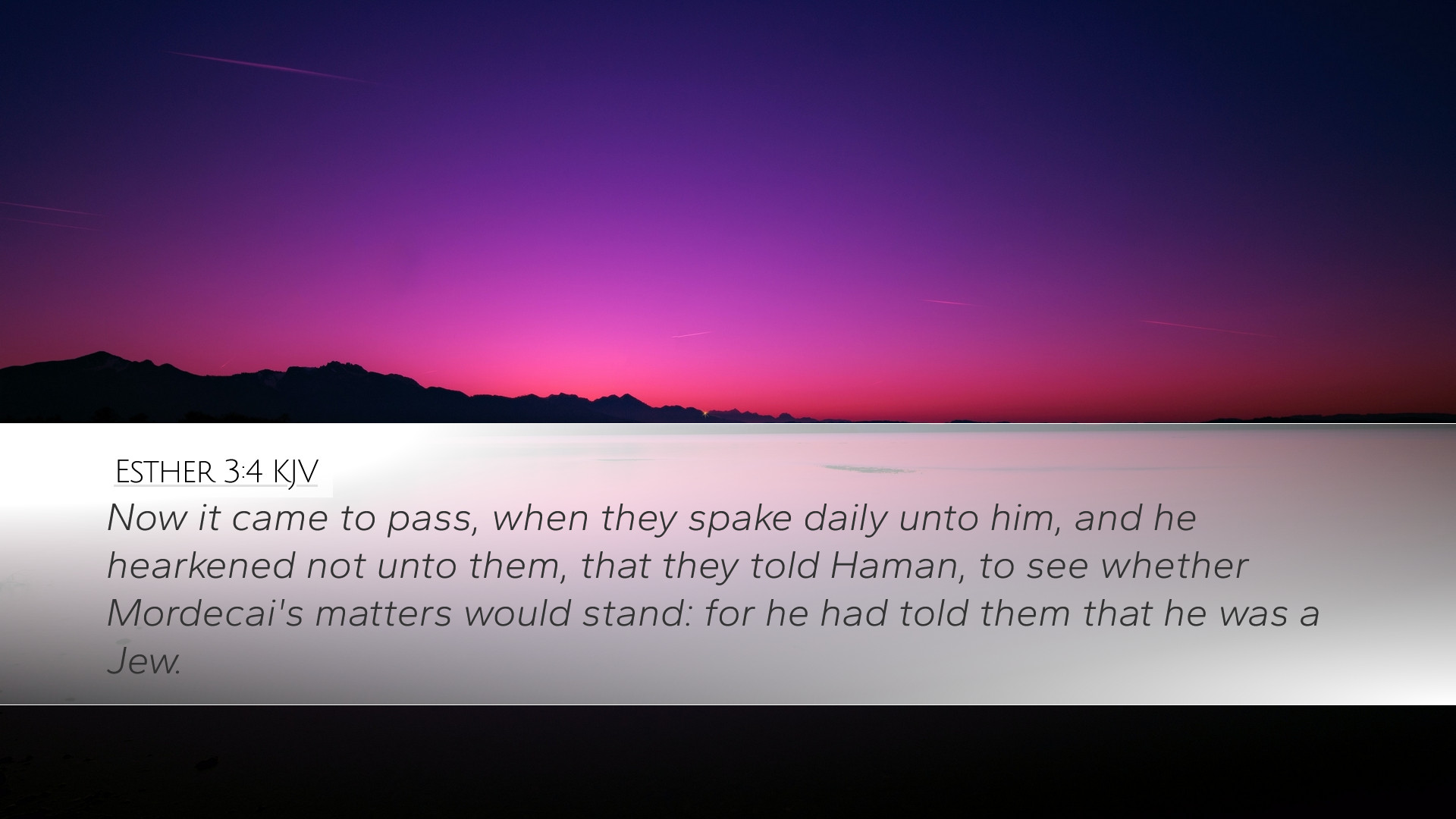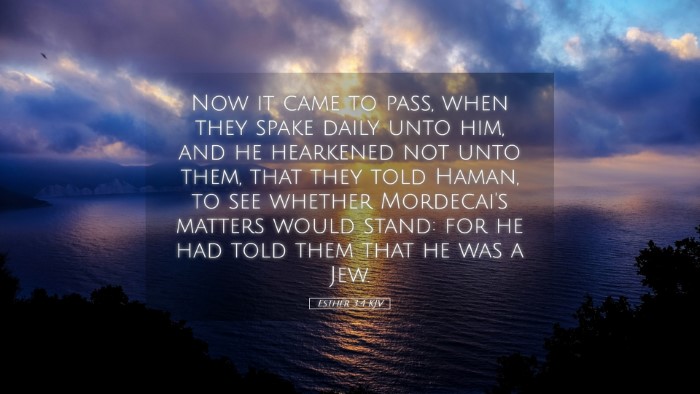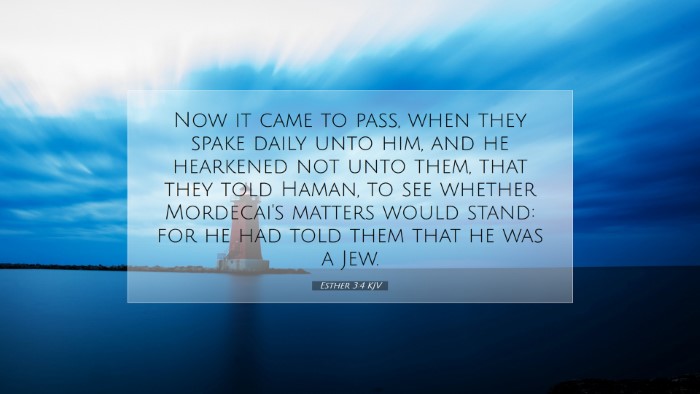Old Testament
Genesis Exodus Leviticus Numbers Deuteronomy Joshua Judges Ruth 1 Samuel 2 Samuel 1 Kings 2 Kings 1 Chronicles 2 Chronicles Ezra Nehemiah Esther Job Psalms Proverbs Ecclesiastes Song of Solomon Isaiah Jeremiah Lamentations Ezekiel Daniel Hosea Joel Amos Obadiah Jonah Micah Nahum Habakkuk Zephaniah Haggai Zechariah MalachiEsther 3:4
Esther 3:4 KJV
Now it came to pass, when they spake daily unto him, and he hearkened not unto them, that they told Haman, to see whether Mordecai's matters would stand: for he had told them that he was a Jew.
Esther 3:4 Bible Commentary
Commentary on Esther 3:4
Esther 3:4 reads: "Now it came to pass, when they spake daily unto him, and he hearkened not unto them, that they told Haman, to see whether Mordecai's matters would stand: for he had told them that he was a Jew."
Introduction
This verse is pivotal in the unfolding drama of the Book of Esther. It highlights the tension between Mordecai, a Jew, and Haman, the Agagite, who despises Mordecai and the Jewish people. The actions of both characters serve to reveal deeper themes of identity, faith, and providence. The commentaries from Matthew Henry, Albert Barnes, and Adam Clarke provide valuable insights into this interaction.
Mordecai's Dilemma
Mordecai's Refusal to Bow
Mordecai’s refusal to bow before Haman is rooted in his Jewish identity and religious convictions. As per Matthew Henry, this act symbolizes Mordecai’s adherence to the first commandment, emphasizing that he worships only the Lord God of Israel. Henry asserts that the refusal to honor earthly authority in a manner that conflicts with divine mandates often puts believers in challenging positions.
The Influence of Community
Esther 3:4 also demonstrates the communal pressure exerted on Mordecai by fellow officials. Albert Barnes notes that Mordecai’s stand would not only affect him but also his surrounding community. The daily entreaties from Haman's servants signify a collective expectation to conform to the king's decree. Therefore, Mordecai’s actions become a testament to his personal conviction but also a reflection of broader societal pressures.
The Role of Haman
The Nature of Haman’s Anger
Haman's reaction to Mordecai's defiance illustrates a critical turning point that leads to the plot against the Jews. Adam Clarke articulates that Haman’s ire is not directed solely at Mordecai but is representative of a larger animosity towards all Jews, rooted in a historical enmity. This conflict unveils Haman’s character as one driven by pride and vengeance, portraying how personal grievances can escalate into widespread hatred.
Symbolism of Haman’s Position
Haman, as the king's highest official, represents a worldly power that seeks the submission of all within the empire. His elevated status, combined with his hatred for Mordecai, sets the stage for a clash between temporal authority and spiritual allegiance. This theme resonates with Matthew Henry, who warns the faithful about the dangers of bowing down to oppressive powers that challenge divine authority.
The Disclosure of Identity
The Importance of Knowing One’s Identity
Mordecai’s proclamation that he is a Jew signifies a profound declaration that carries significant weight throughout the narrative. Albert Barnes emphasizes that Mordecai’s identity is central to understanding the conflict at hand. His declaration not only highlights his ethnicity but also his faithfulness to God and his people.
Cultural Significance
The acknowledgment of his Jewish identity brings to light the societal tensions between the Jews and their Persian rulers. Adam Clarke elaborates that this tension is historical, grounded in the long-standing conflicts between the Israelites and their enemies. Therefore, Mordecai's stand is not merely individual; it encapsulates the collective struggle of the Jewish people, serving as a reminder of their covenant relationship with God.
Theological Reflections
Divine Providence
The events in Esther unfold under God’s providence. Mordecai’s refusal to bow and the subsequent reporting to Haman signal the start of a series of divine interventions. Matthew Henry interprets these occurrences as orchestrations of God's hand, where the apparent despair of the Jewish people is part of a greater plan for deliverance. This invites readers to reflect on God’s sovereignty in the midst of oppression.
Faith and Courage
The courage displayed by Mordecai is a call to faithfulness amidst persecution. Albert Barnes describes this courage as an emblem of faith, urging believers to remain steadfast in their convictions, regardless of the pressures from the world around them. This calls forth a challenge for modern readers on how they address issues of faith identity today.
Conclusion
Esther 3:4 stands as a rich text for theological reflection and application. The interplay between Mordecai and Haman encapsulates themes of identity, faith, courage, and divine providence. The insights from the public domain commentaries illuminate these themes, providing depth to our understanding of the text. As followers of Christ, the commitment to God must often take precedence over the pressures of societal norms. In interpreting this passage, both scholars and laypersons are encouraged to consider their own stands in faith and identity, reflecting deeply on the implications of allegiance to God above all.


